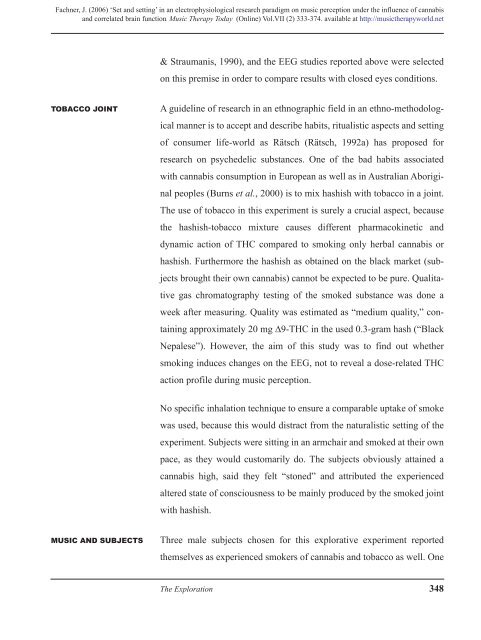Music Therapy Today - World Federation of Music Therapy
Music Therapy Today - World Federation of Music Therapy
Music Therapy Today - World Federation of Music Therapy
Create successful ePaper yourself
Turn your PDF publications into a flip-book with our unique Google optimized e-Paper software.
Fachner, J. (2006) ‘Set and setting’ in an electrophysiological research paradigm on music perception under the influence <strong>of</strong> cannabis<br />
and correlated brain function. <strong>Music</strong> <strong>Therapy</strong> <strong>Today</strong> (Online) Vol.VII (2) 333-374. available at http://musictherapyworld.net<br />
& Straumanis, 1990), and the EEG studies reported above were selected<br />
on this premise in order to compare results with closed eyes conditions.<br />
TOBACCO JOINT A guideline <strong>of</strong> research in an ethnographic field in an ethno-methodolog-<br />
ical manner is to accept and describe habits, ritualistic aspects and setting<br />
<strong>of</strong> consumer life-world as Rätsch (Rätsch, 1992a) has proposed for<br />
research on psychedelic substances. One <strong>of</strong> the bad habits associated<br />
with cannabis consumption in European as well as in Australian Aborigi-<br />
nal peoples (Burns et al., 2000) is to mix hashish with tobacco in a joint.<br />
The use <strong>of</strong> tobacco in this experiment is surely a crucial aspect, because<br />
the hashish-tobacco mixture causes different pharmacokinetic and<br />
dynamic action <strong>of</strong> THC compared to smoking only herbal cannabis or<br />
hashish. Furthermore the hashish as obtained on the black market (sub-<br />
jects brought their own cannabis) cannot be expected to be pure. Qualita-<br />
tive gas chromatography testing <strong>of</strong> the smoked substance was done a<br />
week after measuring. Quality was estimated as “medium quality,” con-<br />
taining approximately 20 mg Δ9-THC in the used 0.3-gram hash (“Black<br />
Nepalese”). However, the aim <strong>of</strong> this study was to find out whether<br />
smoking induces changes on the EEG, not to reveal a dose-related THC<br />
action pr<strong>of</strong>ile during music perception.<br />
No specific inhalation technique to ensure a comparable uptake <strong>of</strong> smoke<br />
was used, because this would distract from the naturalistic setting <strong>of</strong> the<br />
experiment. Subjects were sitting in an armchair and smoked at their own<br />
pace, as they would customarily do. The subjects obviously attained a<br />
cannabis high, said they felt “stoned” and attributed the experienced<br />
altered state <strong>of</strong> consciousness to be mainly produced by the smoked joint<br />
with hashish.<br />
MUSIC AND SUBJECTS Three male subjects chosen for this explorative experiment reported<br />
themselves as experienced smokers <strong>of</strong> cannabis and tobacco as well. One<br />
The Exploration 348

















